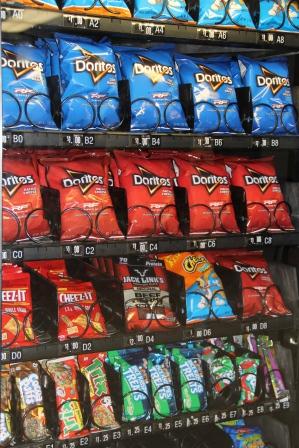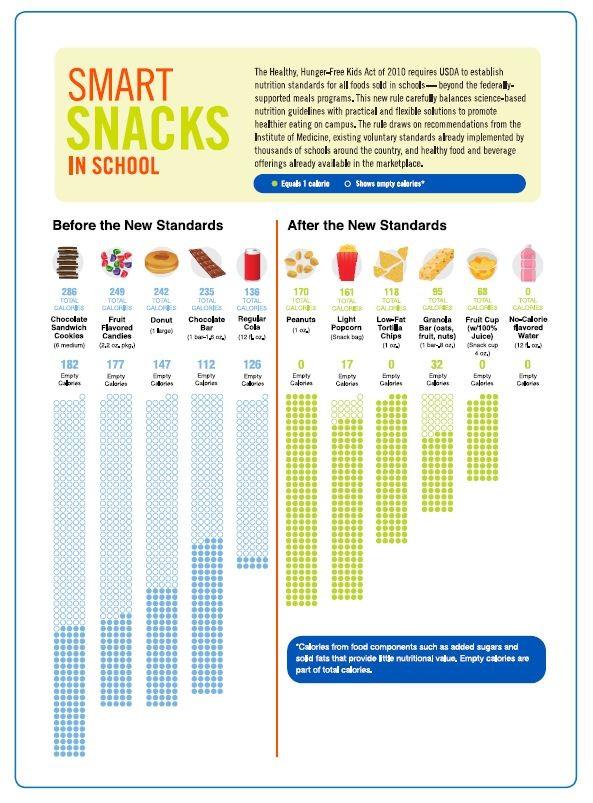New lunch guidelines
Students give Smart Snacks program mixed reviews

The vending machines have different options after the Smart Snacks program took over.
September 4, 2014
Recently Congress passed a bill which was signed into law by President Obama and pushed by First Lady Michelle Obama, to change the nutrition standards on all foods given and sold to students while at school.
The main purpose of Smart Snacks in School is to provide healthier snacks and lunches at school and to help put a stop to child obesity. To do this, schools will now offer healthy foods and limit junk food. All foods are required to meet certain standards.
Lunch entrees must include whole grains, with a fruit, vegetable, dairy or protein product. In addition, it must contain 10% of the Daily Value (DV) of one of the nutrients listed in the 2010 Dietary Guidelines for Americans. Snacks must be less than 200 calories and entrees must be less than 350 calories. Beverages include water, unflavored low-fat milk and/or flavored fat free milk as well as milk alternatives. Elementary schools can have up to eight ounce portions of milk and high schools can have up to 12 ounce portions.
Students have mixed reviews. Some see the new changes as a bad thing and complain that the new meals are not filling enough.
“I do not agree the food should be regulated because of health reasons,” said junior Spencer Busick.
Others, like STUCO member Peighton Hargis, are finding it helpful.
“I like it because we still have good options and they’re healthy. I like that we sell gum [in the student store], because who doesn’t like gum?” she said.
The cafeteria staff also have mixed reviews.
“The kids complain, wondering why some things aren’t the same as last year. But other than that, it’s trying to make it healthier. We can’t do anything about it but go by the rules. I feel like they should have gotten the kids’s opinions on healthier foods rather than just switching it,” Tasha Stevenson said. “Some of the things you guys really liked were taken away, and I don’t feel like that was fair.”
Manager Jesse Feeback said managing the menu under the new guidelines isn’t difficult, because Keystone Food Service has already committed to using fewer processed food products. However, there are still challenges to meeting the requirements.
“There are a few challenges in meeting weekly requirements for the vegetable subgroups but I enjoy those challenges. The biggest change has been whole grain requirements. There are fewer whole grain options out there, so the quality and some of the preparation are challenging at times this year,” Feeback said.
“My biggest complaint will always be that the Federal Government considers milk a separate food group and forces schools to offer it,” he added.
Part of the cafeteria staff feels like nothing has changed.
“We just have to look more closely on what we’re buying so it fits the guidelines,” said supervisor Brenda Seley. “The stuff we serve is more healthy but our food has always been pretty much healthy. It hasn’t changed that much. We’re still basically having the same thing, it’s just that we’re buying more wheat products than flour and what they call the unhealthy foods.”
However, the new changes effect Harding Charter Prep differently than other schools. Since switching to Keystone for food service, plenty of vegetable and fruit options have been offered with a full-service salad bar. As of now, all schools will have to follow the new standards. Take a look at the following link for more information: http://www.fns.usda.gov/sites/default/files/allfoods_flyer.pdf



Anonymous • Apr 3, 2015 at 9:00 am
I hate this new crap they have in vending machines now. I actually had to go to a machine outside of school to get the snacks I really want.